sierraclub.org - sierra magazine - march/april 2011 - mixed media
Last Chance for the Gulf | Earth Beat
LAST CHANCE FOR THE GULF
Savoring a beleaguered region's tastes, sounds, and stories
Last year's BP Deepwater Horizon oil spill was just the latest in a century of environmental catastrophes to hit the Gulf Coast, but it may inspire renewed support for this region of breathtaking natural beauty. Though the price tag for restoration is high, and the oil industry ensconced, money from BP's fines will give us the best shot in decades to save the richest U.S. wetlands, as well as the unique culture built on their bounty. Here is a multimedia primer on the region and its character. —Rowan Jacobsen
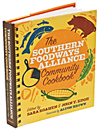
Lori Eanes
Cajun food is the United States' best example of a culinary tradition that, like all great cuisines, evolved from its environment. Now that way of life is threatened by the oil spill.
Stir the Pot: The History of Cajun Cuisine (Hippocrene, 2005) explains the evolution of Cajun food from its beginnings in Acadia in the 1700s. Check out
The Southern Foodways Alliance Community Cookbook (University of Georgia Press, 2010) and the
Southern Gumbo Trail, which combines interactive maps, recipes, and oral histories to tell the complete story of gumbo and, in so doing, the story of a subculture.
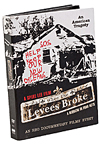
Lori Eanes
New Orleans relies on the surrounding wetlands for everything from seafood to hurricane protection. Its tragedies aren't natural disasters; they're manmade, as Spike Lee makes clear in his tour de force documentary
When the Levees Broke: A Requiem in Four Acts (HBO Home Video, 2006). Dave Eggers provides a nuanced take on the city and its hurricane in
Zeitoun (McSweeney's, 2009), and Tom Piazza makes a strong argument for the city's survival in
Why New Orleans Matters (Harper, 2005). Oliver Houck's
Down on the Batture (University of Mississippi Press, 2010) captures the full weirdness of life on the Lower Mississippi, focusing on the "lively slip" between the river's edge and its levees.
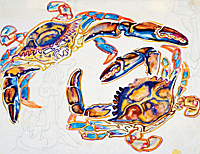 Courtesy of the Walter Anderson Museum of Art
Courtesy of the Walter Anderson Museum of Art
contains some of the Caribbean's healthiest coral reefs, even though it's surrounded by oil platforms and pipelines. An easy place to visit is Horn Island, a barrier island off the Mississippi coast that is part of
Gulf Islands National Seashore and that took a direct hit from the oil slicks and tar balls; it continues to be monitored by cleanup crews.
Fifty years ago, it was the obsession of the brilliant and tortured artist Walter Anderson, who spent decades making thousands of paintings (Blue Crabs shown right) and sketches of the island. His eponymous museum is in Ocean Springs, Mississippi. One of the best clearinghouses for information on all the issues affecting the Gulf of Mexico—as well as what you can do—is the Gulf Restoration Network, especially its ongoing video series, narrated by actor Tim Robbins, about the oil spill and the recovery efforts.
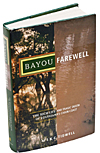
Lori Eanes
Southern Louisiana is the earth's fastest-disappearing landmass. Blame the U.S. Army Corps of Engineers' levees on the Mississippi, which prevent the river from annually flooding and resupplying the wetlands with sediment. John McPhee tells the tale of the river that is higher than the land it passes through in
The Control of Nature (Farrar, Straus and Giroux, 1989). Mike Tidwell makes it clear in
Bayou Farewell: The Rich Life and Tragic Death of Louisiana's Cajun Coast (Pantheon, 2003) that the 8,000 miles of canals the oil industry cut through the wetlands have caused further destruction.
Even a child can understand what's happening, thanks to Wendy Billiot's picture book Before the Saltwater Came (Wendy Wilson Billiot Publishing, 2004). Also check out her blog, Bayou Woman. Quinta Scott's stunning record of the Mississippi's endangered wetlands, The Mississippi: A Visual Biography (University of Missouri Press, 2010), shows what's being lost.

Lori Eanes
The Gulf states are the heart and soul of American roots music. For the best living record of that tradition, check out the collection of
Arhoolie Records. Beginning in 1960, founder Chris Strachwitz began traveling around rural Texas, Louisiana, and Mississippi, following word of mouth to find and record then-unknown blues, Cajun, zydeco, and Tex-Mex musicians. He helped launch the careers of such legends as Mance Lipscomb, Lightnin' Hopkins, and Clifton Chenier, and 50 years later he's still at it.
Because music has always been part of the fabric of the Gulf Coast, it was no surprise that in the weeks after the oil spill, musicians came together to raise money for cleanup efforts and wetland restoration. At Louisiana's Venice Marina, the Lost Bayou Ramblers, Grammy nominees and natives of Lafayette Parish, played a free concert for spill responders. The blog for their new album, Vermilionaire, is devoted to oil spill news and wetlands advocacy.
Adapted from Rowan Jacobsen's Shadows on the Gulf: A Journey Through Our Last Great Wetland (Bloomsbury USA, April 2011:
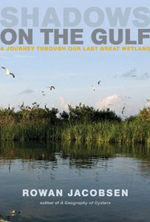 Courtesy of Bloomsbury USA
Courtesy of Bloomsbury USA
It was springtime on the Gulf Coast—mating season. All around us, life was making new life, or at least contemplating the idea. The male sailfin mollies were nudging females toward the privacy of the reeds. Behind us on the salt pan, willets were flitting into the air and piping their pennywhistle love songs. A rail had just hatched her chicks in the cordgrass. At the edge of the marsh, acres of oysters were spawning. And farther out to sea, uncountable crab eggs were riding the warm Gulf currents. This was, normally, the most hopeful time of the year. And Grand Bay sure as hell looked normal. Miles of rush stretched to the Mississippi state line, backed by a wall of some of the only tidal pine forest on earth. The sun glinted off waves rolling over vast seagrass beds.
But we couldn't enjoy it. Ten miles straight offshore from us, the first black cannonade of tar balls was splatting into Dauphin Island, the sandy barrier island that is the coast's first line of defense. Farther out, something dark and dead was gathering in the depths.
ROWAN JACOBSEN's books include The Living Shore: Rediscovering a Lost World
(Bloomsbury USA, 2009) and A Geography of Oysters: The Connoisseur's Guide to Oyster
Eating in North America (Bloomsbury USA, 2007), for which he won a James Beard Award.
EARTH BEAT
Food for Thought
 Chicago ironworker Jeff Devine with his 6,600-calorie daily diet, heavy on the processed foods. | Photo courtesy of Peter Menzel/www.whatieat.org
Chicago ironworker Jeff Devine with his 6,600-calorie daily diet, heavy on the processed foods. | Photo courtesy of Peter Menzel/www.whatieat.org
The husband-and-wife team of photojournalist Peter Menzel and writer Faith D'Aluisio charmed us with Hungry Planet: What the World Eats (Material World, 2005), which gives us the opportunity to compare our weekly food purchases with those of 30 families in 24 countries. Their latest effort, What I Eat: Around the World in 80 Diets (Material World, 2010; whatieat.org), gets even more personal, displaying the daily diets of 80 individuals around the globe. The subjects are organized by the number of calories each consumes on a certain day, from the 800 calories of a Kenyan herder to the 12,300 of a binge eater in the U.K. Sierra spoke with D'Aluisio for a taste of what motivates the couple.
Photographing one person with their meals makes the topic personal for a regular reader. We want to present the entire work as non-polemically as possible.
It's easy. Food touches everyone. It's an entry into the working of the family unit. The conversation starts with food and ends up being about life. People want to share; they want to see you eating their food.
Peter was adamant about that, and at first it drove me nuts. I would have organized them by continent. But it turns out to be an interesting way to pull the individuals out of their geographic context. By happenstance, American sustainable farmer Joel Salatin follows Latvian voice coach Ansis Sauka, both at 3,900 calories.
Our readers are largely from the U.S. It made the most sense as a point of comparison and contrast.
"Ideal" is in the eye of the beholder. It depends on what's appropriate for the region and for an individual's level of activity. Our Tibetan yak herder (5,600 calories) has a butter-rich diet, but he burns off a lot of calories. Generally, grain-based diets with little packaged food are best.
Highly processed food from the global marketplace is changing what people eat everywhere. As people get more money, they buy more meat, sugar, dairy, and highly processed packaged food. People are less likely to know what they're eating, and obesity is becoming more and more of an issue.
I address our methodology in the introduction, but when it comes to food, there are people far smarter than us to turn to. And I don't want to tell people how to live their lives.
I love cheese and anything fermented. Peter loves sugar.
—interview by Reed McManus